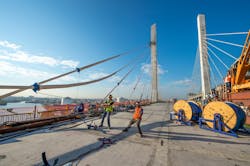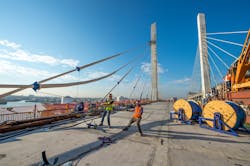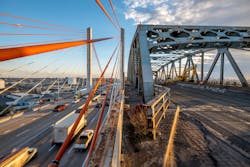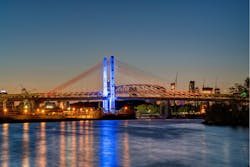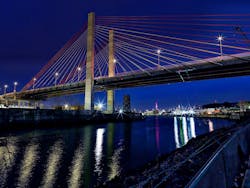A new bridge crossing in NYC
Newtown Creek sounds like a small, meandering stream suitable for splashing in during warm summer months.
In reality, New York City’s Newtown Creek, which forms part of the boundary between Brooklyn and Queens, is a 3.5-mile-long tributary that served as a major industrial waterway in the mid- to late 1800s.
Bridges have provided access across the creek for hundreds of years. Today, four of them span its width. The newest of these is the Kosciuszko Bridge, a diaphanous-stranded beauty that is not only New York City’s first major cable-stayed bridge, but also the first new bridge of any kind constructed in the gateway city in 50 years.
NYSDOT elected to replace the existing K-Bridge with twin cable-stayed bridges built in two phases. Photo: Andy Ryan, courtesy of HNTB.
A bigger need
By the turn of the 21st century, the original Kosciuszko Bridge, a through-truss structure built in 1939, had outlived its useful life. Sixty years after its opening—and now carrying the Brooklyn-Queens Expressway/I-278—the bridge conveyed upwards of 160,000 vehicles per day. By 2015, the number of daily vehicles crossing the bridge had increased to 180,000, placing an enormous strain on a span originally designed to transport only 10,000 vehicles each day, as well as surrounding neighborhoods that were dealing with clogged roadways due to a lack of proper capacity on the bridge.
The crossing had narrow lanes and no shoulders. Steep approaches rose from the highways on either side of the waterway to the bridge’s center section. The steep grades were necessary in an era when tall naval ships sailed Newtown Creek, but now created problems for heavy trucks, which had difficulty making the precipitous climb and then regaining highway speeds.
Since the late 1980s, the bridge’s owner, the New York State Department of Transportation (NYSDOT), had spent a great deal of time and money maintaining a state of good bridge repair. These frequent band-aid efforts, while critical to keeping the bridge operating, required lane closures that exacerbated already congested conditions. Those fixes also were insufficient to provide long-term solutions to the structure’s bigger problems.
The support steel underlying the roadway was deemed to be structurally deficient in a 2008 inspection, which also pointed out other issues of concern on the bridge. Because it was no longer a good use of taxpayer money to continue repairing the bridge at that point, NYSDOT wasted no time in deciding to replace the outdated structure.
“By replacing the bridge, we address its deficiencies—the steep roadway grade, narrow lane widths and lack of shoulders,” said NYSDOT Project Director Robert Adams.
NYSDOT elected to replace the existing Kosciuszko Bridge, commonly called the K-Bridge, with twin cable-stayed bridges built in two phases. Phase 1 involved construction of the westbound span, built alongside the existing K-Bridge, that would carry traffic into Queens. Shortly after that span was completed in April 2017, NYSDOT demolished the old bridge. HNTB conducted analyses to ensure the existing bridge would be stable and structurally sound as crews dismantled it in pieces.
With five standard-width lanes and two full-width shoulders, the new westbound crossing is accommodating both directions of traffic until the Brooklyn-bound span is built in phase 2.
After the completion of the westbound span into Queens, NYSDOT demolished the old bridge. Photo: Andy Ryan, courtesy of HNTB.
Fast-track bridge design
Despite the clarity of NYSDOT’s decision, the actual work of replacing the old bridge would be no easy task. The project entailed relocating decades-old underground utilities, resolving major drainage issues and avoiding an active hazardous-waste site. It also required working in a highly constrained urban environment while maintaining traffic on the Brooklyn-Queens Expressway throughout construction.
To meet those challenges, NYSDOT selected Skanska-Kiewit-ECCO III Joint Venture, awarding a $555 million phase 1 contract, the largest single contract in the department’s history. The Skanska-Kiewit-ECCO III team subsequently chose HNTB to serve in the role of lead designer.
NYSDOT originally planned to complete the Kosciuszko Bridge project under four design-bid-build contracts, with a projected completion date of 2024. Ultimately, however, new state legislation permitted the department to proceed with a design-build delivery method, another first in New York City and an opportunity that shaved three to four years off the completion time. The department established an aggressive schedule for both new construction and demolition of the old bridge to be completed by late 2017, just 43 months from notice to proceed. Meeting the demanding schedule would mean that NYSDOT could begin phase 2 construction on the Brooklyn-bound span as planned in summer 2017.
A cable-stayed structure requires rigorous computations, making it one of the most complex bridges to design and one of the most difficult to deliver under design-build. When HNTB first considered design-build delivery for the bridge, its engineers anticipated design to take between 12 and 15 months. However, recognizing that SKE wanted to start installing the main span’s drilled shafts in October 2014, HNTB expedited the design process, ultimately completing plans within seven months.
“For a cable-stayed bridge, that is the epitome of accelerated,” said Hans Hutton, HNTB engineer of record for the cable-stayed unit.
Within just seven months, HNTB had conducted wind-engineering and wind-tunnel testing, performed non-linear time-history analyses, progressed the design to the 100% level and completed design of the bridge. The time-history analysis of the 1,001-ft-long, cable-stayed unit demonstrated that, should any of the bridge’s 56 cables break suddenly, the bridge would not sustain other damage. Other analyses showed that damage incurred in a 2,500-year seismic event would be limited and repairable.
Among the key project challenges was ensuring that the K-Bridge would achieve aeroelastic stability. If wind turbulence levels at the site had been lower than 13%, the span would not have met industry-established vibration criteria. HNTB and RWDI Consulting Engineers and Scientists measured turbulence using an ultrasonic anemometer, which proved that the site experienced turbulence above 13%.
Continual communication between SKE, HNTB and NYSDOT supported fast-track design completion.
“The team met frequently and was committed to addressing issues quickly so everyone could continue working,” Adams said. “That helped everyone stay on schedule, so the focus could be on doing quality work and delivering the job safely.”
“We gave SKE advance notice of where work could proceed and where remedial actions might be needed, so schedule changes were not a surprise,” said HNTB Project Manager Jim Peterson. “And the department received assurance that traffic patterns and motorist safety could be maintained on the existing bridge.”
At the peak of design, more than 150 HNTB employees coast-to-coast supported the effort.
The new Kosciuszko Bridge, designed and built to withstand a century’s worth of heavy traffic, opened ahead of schedule in April 2017 with a ceremony attended by Gov. Andrew Cuomo. Photo: Andy Ryan, courtesy of HNTB.
Overcoming design challenges
Most cable-stayed bridges are equally loaded three-span symmetrical bridges with two towers, but NYSDOT’s preferred design features a pair of single-tower, cable-stayed spans. Pylon heights had to be restricted because of nearby LaGuardia Airport, and to avoid a railroad right-of-way and environmentally sensitive areas below the bridge, the spans had to be designed with unequal lengths.
At 624 ft, the main span is longer and heavier than the 377-ft back span, a configuration that created uplift on the shorter span. HNTB balanced the lighter mass with a 9,000-kip concrete counterweight. The main span tower is supported by eight drilled shafts, each 7 ft in diameter. These shafts extend approximately 160 ft below ground and are drilled into rock.
During construction of the superstructure and cables, the team also analyzed each step of the bridge erection process to achieve the necessary balanced loading. The cable angles had to be flatter than desired to accommodate the 303-ft tower height, nearly as tall as the Statue of Liberty. The flat angles created high force, which was addressed by specifying the use of larger cables.
HNTB also was tasked with designing the Brooklyn connector, a particular challenge because it needed to occupy the same space as the old Brooklyn approach viaduct, with the same alignment on the same elevation, and the old structure had to be replaced while remaining operational.
The team considered a 1-mile temporary bridge to serve traffic while the viaduct was replaced, but the cost and time required for that concept were prohibitive. Instead, HNTB designed and SKE built the viaduct in kind, one lane at a time, while traffic continued to flow. The team moved traffic into the far left-hand side of the existing viaduct while the far right-hand lane was deconstructed and a new lane was built in its place, a concept known as “replace-in-place.”
The design called for constructing approximately 2,000 ft of earth-filled embankments under the existing viaduct, using prefabricated modular retaining walls known as T-walls. The proposed embankments were constructed in tight quarters adjacent to and beneath the existing viaduct.
The new K-Bridge also takes advantage of several industry trends. For example, the team used a polyester polymer overlay, which is less sensitive to the environment than other materials, to protect the bridge deck; used highly compact steel anchor boxes inside the bridge pylons; and used metalized exposed steel surfaces, which are becoming the preferred corrosion protection in marine/coastal environments. Further, because major bridge installations are potential terrorist targets, the team identified and incorporated security measures to mitigate intentional damage to the bridge.
The new K-Bridge, designed and built to withstand a century’s worth of heavy traffic, opened ahead of schedule in April 2017 with a ceremony attended by Gov. Andrew Cuomo. It features wider travel lanes, standard shoulders and reduced roadway inclines, enabling trucks to maintain a consistent speed on the bridge. It created a signature skyline element between Brooklyn and Queens, and makes this critical corridor in New York City’s transportation network safer, more effective and more efficient.
Being a cable-stayed structure, the new Kosciuszko Bridge was among the most complex bridges to design and most difficult to deliver under design-build. Photo: Andy Ryan, courtesy of HNTB.
